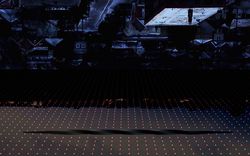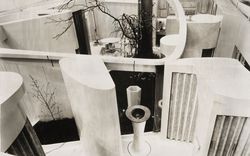1939: The Future in Flushing Meadows
Text by Nancy Levinson. Photographs by Frank Navara
The photographic record of the 1939 New York World’s Fair is vast—a measure of the city’s ascendancy to world capital and also of the cultural reach of the event itself, which promoted, as an American Studies project at the University of Virginia puts it, “one of the last great meta-narratives of the Machine Age: the unqualified belief in science and technology as a means to economic prosperity and personal freedom.”
And what a meta-narrative it was! The theme of the fair was “Building the World of Tomorrow.” To stage the world of tomorrow, the New York World’s Fair Corporation redeveloped 1,216 acres in Queens, transforming the Corona Ash Dump (immortalized in F. Scott Fitzgerald’s The Great Gatsby as the “desolate area…the valley of ashes” between the city and the “white palaces” of East Egg) into the Flushing Meadows-Corona Park (which twenty-five years later would be the site for another world’s fair). The detoxified fairgrounds hosted buildings from sixty nations and hundreds of major corporations, created by celebrated architects and designers. Pavilions showcased masterpieces of Western art (Michelangelo, Rembrandt, etc.); installations by contemporary artists including Salvador Dalí; a copy of Magna Carta (one of only four surviving original documents, on loan from Lincoln Cathedral); and demonstrations of emerging consumer technologies such as fluorescent lighting, nylon, air-conditioning, automatic dishwashers, electric calculators, computer graphics, and television.
At the center of the fair were the famous Trylon obelisk and the Perisphere, a two-hundred-foot globe constructed of steel and concrete and designed by architects Wallace Harrison and J. Andre Fouilhoux that contained a diorama called Democracity, designed by Henry Dreyfuss. Franklin Roosevelt and Albert Einstein spoke on the opening day in April 1939. Forty-five million people visited. Westinghouse sponsored a time capsule containing microfilm records of art, literature, and history as well as miscellaneous artifacts including a copy of Life magazine and a pack of Camels; made of a corrosion-resistant alloy, the capsule remains buried under Flushing Meadows and is intended to be opened in 6939, five thousand years after the fair.
The fair’s world of tomorrow, as we know now, was more or less the suburbia of today. Here is E. B. White describing his visit to the most popular pavilion, Futurama, sponsored by General Motors and designed by Albert Kahn and Norman Bel Geddes, a vision of the city-utopia of 1960, where everybody owned a car and the roadways were wide and glamorous:
The countryside unfolds before you in $5-million micro-loveliness, conceived in motion and executed by Norman Bel Geddes. The voice is of utmost respect, of complete religious faith in the eternal benefaction of faster travel. The highways unroll in ribbons of perfection through the fertile and rejuvenated America of 1960 — a vision of the day to come, the unobstructed left turn, the vanished grade crossing, the town which beckons but does not impede, the millennium of passionless motion. When night falls in the General Motors exhibit and you lean back in the cushioned chair (yourself in motion and the world so still) and hear (from the depths of the chair) the soft electric assurance of a better life — the life which rests on wheels alone — there is a strong, sweet poison which infects the blood. I didn’t want to wake up.
By the time the fair closed, in October 1940, everybody had woken up. Earlier that fall the Battle of Britain had begun, and Londoners were sheltering in the Underground. Magna Carta would remain in the US until 1947, in Fort Knox, because to transport it back home was understood to be too dangerous. Three-quarters of a century on, it’s hard to project back to the world of the world’s fair. These days we aren’t much disposed to technocratic meta-narratives that promise unlimited technological progress, and now when we view the images—these are by the New York-based photographer Frank Navara (1898–1986)—we know that what was soon to come was not the world-of-tomorrow but the world at war.
But if it’s easy to dismiss the 1939 World’s Fair—its imagery and themes, its corporate paternalism and nationalist rhetoric—as hokey, we might still wonder how future generations will judge our own similar efforts. For the lure of the big vision and the spectacular rendering can be hard to resist. Witness all the recent competitions and exhibitions that call for bold ideas about the city of the future and the next-generation of infrastructure and suburbia. Given the widespread political distrust of public works and megaprojects—and the privatization that’s become one of the meta-narratives of our own time—it’s not likely that the worlds-of-tomorrow being envisioned today will be realized any time soon. But if nothing else they’ll constitute a gorgeous archive of what tomorrow looked like today.
Nancy Levinson was a Visiting Scholar here in 2012.

































